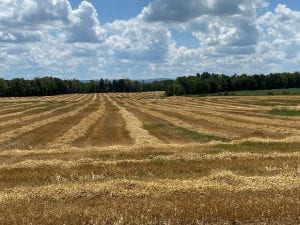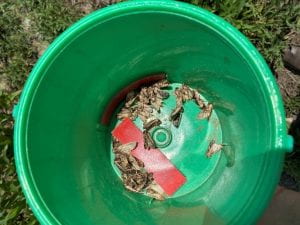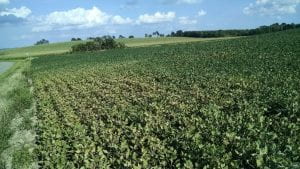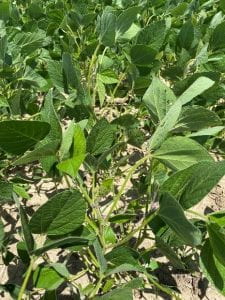Wheat Harvest has Begun!

Wheat harvest has begun throughout the region and yield reports have been positive. With the increase in fertilizer prices this year, the nutrient value of straw is important to consider. Numbers from Ohio and Michigan State have shown that a ton of wheat straw contains from 11-13 pounds of N, 3-3.3 pounds of P and 20-23 pounds of K. For further details see this article from OSU. Penn State Extension Educator, Andrew Frankenfield discusses the breakeven point for wheat straw in this article Straw: To Bale or Not to Bale?
Western Bean Cutworm Moths Have Emerged

This week, we collected our first Western Bean Cutworm (WBC) moths in NWNY using pheromone traps. The WBC trap network is re-established throughout the state in order to monitor adult emergence. Historically, peak emergence has occurred around August 1st. Females favor laying eggs in pre-tasseled corn. Scouting for western bean cutworm should begin. Here is a good piece from Chris DiFonzo out of Michigan on how to scout and make insecticide application decisions. Remember that only plants with Viptera Bt will be protected from insect eating damage. 5% or more of the plants must contain egg masses to meet the threshold.
Adjusting Harvest Management Decisions in a Drought Situation

NWNY has averaged mid-80s to 90s with increasing humidity and a moderate drought in certain regions. It’s DRY? We’re seeing stunted hay fields with insufficient regrowth for third cutting due to a lack of moisture. Many wonder how to handle drought-stricken hay fields with old, mature vegetation. Will mowing stimulate fall growth if there’s enough rain?
If the crop is “shut down,” new growth is rare after a rain, thus grasses or mixed stands should be cut high (4″) to encourage new growth and manage weeds and pests. If there’s adequate growth and the alfalfa is dormant and dropping leaves, mowing will help salvage feed, but I don’t recommend mowing new alfalfa or grass seedings if they’re drought stressed. If you have weeds or pests, mow high.
If stands won’t provide enough hay or haylage to cover harvest costs and grazing isn’t an option, leaving them uncut won’t hurt them unless Potato Leafhoppers (PLH) are present. This insect is prevalent in hot, dry conditions. We have not had much of a problem with PLH however pea aphids are making up the difference right now. When plant damage is obvious, it’s too late to treat. To manage pests and promote new growth, trim these fields. Remember what Quirine Ketterings and Karl Czymmek said, “You can’t fertilize out of a drought.” Plants need moisture to absorb most nutrients, and dry circumstances reduce fertilizer use and crop response.
Spider Mite Injury in Soybeans

If plants are under stress from drought, spider mites will soon follow. I’ve observed low levels of leaf stippling and this week received my first report of considerable outbreaks. The injury was scattered around the field. Eventually, the silvery specks will become yellow. Remember that there have been no recognized mite per plant thresholds. Mites proliferate rapidly, and the damage they cause will be exacerbated by the drought conditions. Once heavy leaf stippling and leaf yellowing are seen, it is time to pursue them. You cannot reduce the stress caused by drought, but you can alleviate the stress caused by mite feeding. There are relatively few products available for the treatment of two-spotted spider mites. Products labeled on soybeans include bifenthrin mixes such as Hero and Argyle, dimethoate and the miticides Agri-Mek and Zeal SC.
Hot Temperature Effects on Soybeans

The recent heat and lack of rain has some producers questioning how their soybeans will be affected. Soybean yield losses are typically experienced when heat stress occurs during germination and reproduction. Right now, soybean fields planted in May are hitting the R2 (full bloom) growth stage. Heat stress can shorten the flowering period but if we get some rain during this time the plant should be able to produce and retain new blossoms to make up for what was aborted during R2. The greatest yield losses occur between the middle of R4-R5 growth stages and is something to keep in mind as we continue to experience dry conditions. For further details see this article from MSU.


